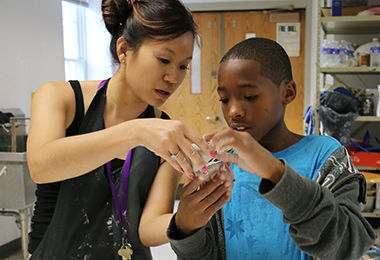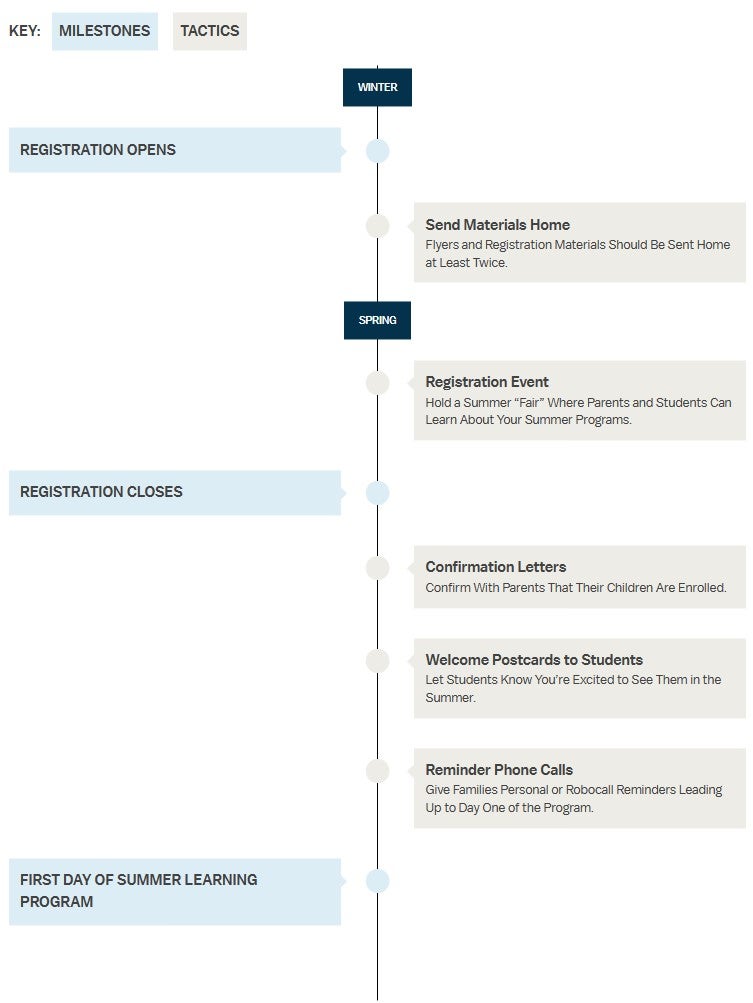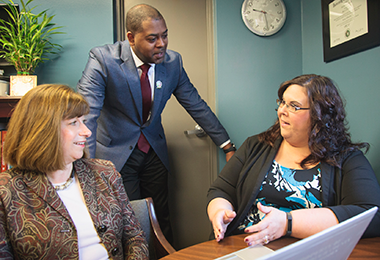Breadcrumb
- Wallace
- Toolkits
- Summer Learning Recruitment Guid...
Summer Learning Recruitment Guide

Why a Recruitment Effort is Crucial
To attract students who can benefit from a voluntary summer learning program, you need a plan. Sending a flyer home or advertising once in the local newspaper isn't enough to reach busy parents. Several factors make an intentional recruitment effort necessary:
- Many parents and students are not used to thinking of summer as a time of learning.
- Voluntary summer learning programs compete with many other programs and activities for the attention of parents.
- Voluntary programs require that parents and students choose to attend.
- School districts must overcome the negative perceptions of traditional summer school that many parents have.


59% of school-aged children from low-income families take part in sports,compared with 84% percent of children from wealthier families.
— Source: Pew Research Center
Summer learning can help close the opportunity gap.
The Value of Outreach to Low-Income Families
Many public school districts are looking to expand or launch voluntary summer learning programs, especially for children from low-income families. These children can experience setbacks over the summer compared with their more affluent peers. A number of studies have found that students from low-income families learn less during the summer than students from higher-income families.
Students from low-income communities can also face an opportunity gap—they are less likely to have access to the enriching, nonacademic experiences that students from higher-income communities usually have.
Voluntary summer learning programs that offer a mix of academics and fun enrichment activities could help reduce these disparities, potentially leading to better academic and social-emotional outcomes for students from low-income families.

September is not too soon to start planning your recruitment effort.

Sample Recruitment Timeline
As you develop your recruitment strategy, you'll want to create a written plan. Below is a sample timeline to give you a sense of the kinds of outreach activities needed throughout the year. The timeline is divided into four main phases: increasing awareness in the fall, registering students in late winter/early spring, ramping up registration efforts in late spring, and encouraging students to show up on day one. The specific activities are all discussed in detail in the Create Your Game Plan section.

Case Study
Achieving your recruitment goals often requires course corrections. The Dallas Independent School District and Big Thought decided to take a new approach in response to some eye-opening research findings.

View the case study
A Fair Approach to Registration: A Dallas Case Study
To help inform their recruitment strategy, the Dallas Independent School District and its nonprofit partner Big Thought hired a research firm to conduct surveys and focus groups of parents whose children participated in the district’s summer learning programs. They found that almost 80 percent of students registered because of information sent home from school. They also learned that many parents wanted more details about the programs like what the curriculum covered.
Perhaps the most important insight from the research was that students who registered were more likely to be from relatively affluent families than the low-income families the district hoped to attract. The reason? Online registration, which the district relied on heavily in the past, discouraged many parents because they didn’t have ready access to computers.
As a result, for summer 2017, the district took a different approach, seeking to make registration as simple and appealing as possible not only for parents but for principals and staff. “We encourage principals to promote summer learning for their students who can most benefit,” said Crystal Rentz, Director of Summer Learning & Extended Day Services at Dallas ISD. “Our principals have a rigorous evaluation heavily weighted on student achievement. We talk to the principals, helping them see that summer learning can help students at-risk get the boost they may need.”
To make the process easy, each school received the exact number of promotional materials it needed so school staff didn’t have to make copies. And, unlike in past years, parents were not instructed to send completed registration forms back to their child's school, so there was no need for a staff member to track registrations (except at the schools hosting the summer programs, which had additional staff to provide support).
Instead, parents throughout the district were invited to the “Discover Summer PREP U Super Saturday and Resource Fair.” This event, held at a centrally located elementary school with plenty of parking and access to public transportation, was a one-stop shop for families to explore a variety of summer learning opportunities and talk directly to program staff. Parents could register their child for a program and immediately get confirmation that they had secured a slot.
To publicize the fair, postcards were sent to parents throughout the district. Flyers were delivered in bulk to each school. So were posters and yard signs. The mayor attended. Local media covered the event. The result—more than 4,000 parents and students attended.
Summary
Summer learning programs have the potential to increase opportunities and improve outcomes for students from low-income backgrounds. Intentional outreach to these students is critical. Start planning early and involve key stakeholders in the community. Connect with parents early and often to ensure the success of your recruitment effort.

Involving Key Stakeholders
Early in the planning process, ask yourself this: Who are the people needed to make my recruitment program a success? The answer should include district leaders, such as the chief academic officer or other members of the superintendent’s “cabinet,” who can help push your efforts forward when they hit a roadblock. It should also include central office staff members who directly supervise principals, as well as principals at the schools hosting summer learning programs. The answer will likely also include community partners that provide summer enrichment programming. Bring them in early.
GET THE LATEST UPDATES
